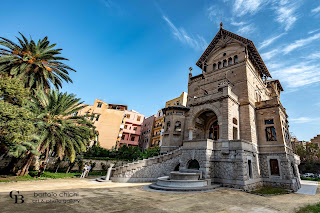Itinerario Turistico - Tourist Itinerary - Le Gole di Tiberio - The gorges of Tiberius
Le Gole di Tiberio dal 2001 sono uno dei siti European Geoparks Network riconosciuto dall’UNESCO per le sue valenze geologiche, così il territorio delle Madonie entra a far parte delle E.G.N.
Il geosito è costituito da una gola fluvio-carsica incisa dal fiume Pollina in corrispondenza di rocce carbonatiche Mesozoiche affioranti dai sedimenti numidici dov’è possibile rinvenire fossili del Giura-Cretaceo.
Nei periodi di basso apporto idrico del corso d’acqua (giugno-settembre), lungo le pareti sono visibili morfologie legate all’azione fluviale e del carsismo.
I Geositi possono essere definiti come elementi puntuali o di modesta superficie di ambienti naturali da conservare, per il loro particolare pregio ed interesse scientifico, estetico e culturale, al quale è attribuito un valore, che presenta un particolare interesse per la comprensione della storia della terra, del clima e della vita.
Il Bene geologico può caratterizzare le forme del paesaggio, essere sito mineralogico, giacimento fossilifero, emblema di un modo di emersione delle acque sotterranee; ovvero, qualificarsi come una componente scientifica, culturale e/o etno-antropologica di un determinato territorio.
Si trovano nel territorio di confine fra il Comune di San Mauro Castelverde e quello di Castelbuono, lungo il fiume Pollina. Si tratta di affioramenti di calcari mesozoici modellati dall’erosione fluviale lunghe circa 250 metri, nacquero nel triassico superiore, circa 200 milioni di anni fa.
Uniche in tutto il comprensorio madonita, costituiscono un ambiente di straordinario impatto paesaggistico e di notevole interesse naturalistico, poiché le levigate e strapiombanti pareti sono habitat ideale per numerose specie vegetali ed animali, soprattutto uccelli, tipiche degli ambienti rupestri.
Il corso d’acqua, la cui portata è considerevole anche in primavera inoltrata, forma una serie di laghetti, piccole cascate, giochi d’acqua di grande suggestione ed è sontuosamente bordeggiato dalla incontaminata vegetazione tipica di questi ambienti, ove spiccano oleandri, salici, pioppi, tamerici, giunchi, canne e numerose specie erbacee.
In particolare, all’interno delle gole si possono osservare: u Miricu, i numerosi nidi di varie specie di uccelli, i fossili di gasteropodi risalenti a circa 150 milioni di anni fa, il masso che fa da ponte naturale sulle gole, un tempo passaggio segreto dei briganti e ricercati che abitavano le numerose grotte e nascondigli della zona, i giochi di luce, una vegetazione incontaminata ed, infine, l’area nudista opera d’arte contemporanea realizzata nel 2005 da Robert Pruitt.
Da decenni il sito è meta di turismo escursionistico e scientifico. Per gli amanti di sport fluviali poiché proprio in corrispondenza delle Gole il fiume diventa navigabile ed in primavera- estate vi si può fare anche il bagno.
Since 2001, the Tiberio Gorge has been one of the European Geoparks Network sites recognised by UNESCO for its geological value, so the Madonie area has become part of the E.G.N..
The geological site consists of a fluvial-karst gorge cut by the Pollina River in correspondence with Mesozoic carbonate rocks outcropping from Numidian sediments where it is possible to find fossils from the Jura-Cretaceous period.
During the periods of low water supply of the watercourse (June-September), morphologies linked to the fluvial action and karstification are visible along the walls.
Geosites can be defined as punctiform or small surface elements of natural environments to be preserved, due to their particular value and scientific, aesthetic and cultural interest, which is attributed a value, which is of particular interest for the understanding of the history of the earth, climate and life.
The geological asset can characterise the forms of the landscape, be a mineralogical site, a fossiliferous deposit, an emblem of a way of emerging groundwater; or, qualify as a scientific, cultural and/or ethno-anthropological component of a given territory.
They are located in the border area between the municipalities of San Mauro Castelverde and Castelbuono, along the Pollina river. They are outcrops of Mesozoic limestone modelled by river erosion, about 250 metres long, created in the Upper Triassic, about 200 million years ago.
Unique in the whole Madonie district, they constitute an environment of extraordinary landscape impact and considerable natural interest, since the smooth and overhanging walls are the ideal habitat for numerous plant and animal species, especially birds, typical of rocky environments.
The watercourse, whose flow rate is considerable even in late spring, forms a series of small lakes, small waterfalls, and highly suggestive water games and is sumptuously bordered by the uncontaminated vegetation typical of these environments, where oleanders, willows, poplars, tamarisks, rushes, reeds and numerous herbaceous species stand out.
In particular, inside the gorges, it is possible to observe: u Miricu, the numerous nests of various species of toadstools, gastropod fossils dating back 150 million years, the rock that acts as a natural bridge over the gorges, once a secret passageway for brigands and fugitives who lived in the numerous caves and hideouts in the area, the play of light, uncontaminated vegetation and, finally, the nudist area, a work of contemporary art created in 2005 by Robert Pruitt.
The site has been a destination for hiking and scientific tourism for decades. For river sports enthusiasts, as the river becomes navigable at the Gorge, it is also possible to swim in spring and summer.




Commenti
Posta un commento